Military
Bombers
B1
B2
B-52
B-25
B-29
return
|
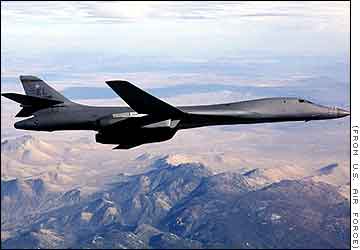
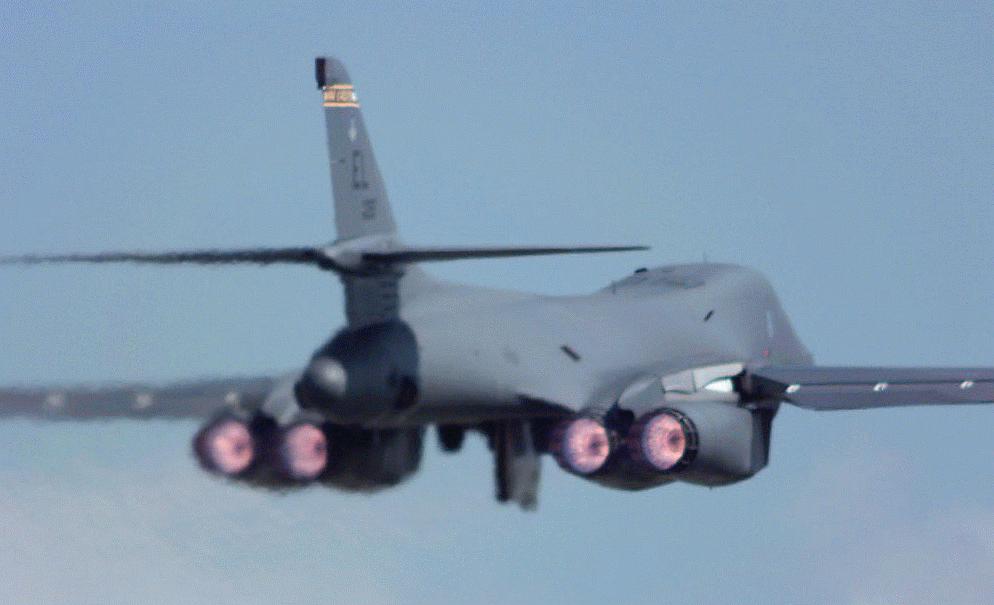
The B-1 is a
long-range strategic bomber with a distinctive streamlined shape. It was
originally designed to deliver nuclear weapons to targets in defended
Soviet airspace, but can carry a variety of conventional arms as well.
|
B1-B
Lancer
Primary function: Long-range, multi-role, heavy
bomber
Builder:
Boeing, North America (formerly Rockwell)
Speed: 900+ mph
(mach 1.2)
Armament: Short-range attack missiles, bombs and cruise missiles
Crew: Four (aircraft commander, copilot, offensive systems
officer and defensive systems officer)
Power
plant: Four General Electric F-101-GE-102 turbofan engine with
afterburner
Thrust:
30,000-plus pounds with afterburner, per engine
Length:
146 feet (44.5 meters)
Wingspan:
137 feet (41.8 meters) extended forward, 79 feet (24.1 meters) swept aft
Height:
34 feet (10.4 meters)
Weight:
Empty, approximately 190,000 pounds (86,183 kilograms)
Maximum
Takeoff Weight: 477,000 pounds (216,634 kilograms)
Range:
Intercontinental, unrefueled
Ceiling:
More than 30,000 feet (9,144 meters)
Date
Deployed: June 1985
Unit
Cost: $283.1 million (fiscal 98 constant dollars)
Inventory:
Active force, 51 primary mission aircraft inventory (72 actual), 2
(test); ANG, 18 PMAI (20 actual); Reserve, 0
Photos:
photo1 photo2
photo3 photo4
B1-B
Video
|
Armament:
Three internal weapons bays can accommodate up to 84 Mk-82 general purpose bombs
or Mk-62 naval mines, 30 CBU-87/89 cluster munitions or CBU-97 Sensor Fused
Weapons and up to 24 GBU-31 JDAM GPS guided bombs or Mk-84 general purpose bombs
http://www.af.mil/news/factsheets/B_1B_Lancer.html
http://www.fas.org/nuke/guide/usa/bomber/b-1b.htm
http://www.fas.org/nuke/guide/usa/bomber/b-1b_gallery.htm
(photos)
http://www.aerotechnews.com/phtoarc/webphot/b1b/b1b7jpg.html
(photos)
|
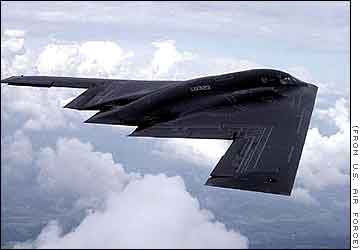
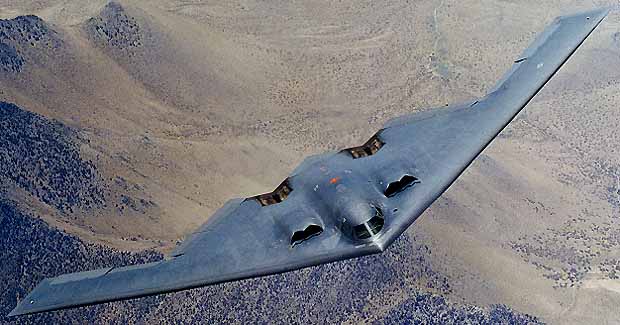
The B-2 Spirit
is a multi-role bomber capable of delivering both conventional and
nuclear munitions anywhere on the globe. Its "stealth"
characteristics blend low-observable technologies with high aerodynamic
efficiency and large payload, providing greater freedom of action at
high altitudes. This increases its unrefueled range to approximately
6,000 nautical miles.
|
B-2
Spirit
Primary function: Multirole heavy bomber
Speed: High subsonic
Armament: Conventional or nuclear weapons
Crew: Two pilots
Prime
Contractor: Northrop Grumman Corp.
Power
Plant/Manufacturer: Four General
Electric F-118-GE-100 engines
Thrust: 17,300
pounds each engine (7,847 kilograms)
Length: 69
feet (20.9 meters)
Height: 17
feet (5.1 meters)
Wingspan: 172
feet (52.12 meters)
Ceiling: 50,000
feet (15,152 meters)
Takeoff
Weight (Typical): 336,500 pounds (152,635
kilograms)
Range: Intercontinental,
unrefueled
Payload: 40,000
pounds (18,000 kilograms)
Crew: Two
pilots
Unit cost: Approximately
$2.1 billion [average]
Date
Deployed: December 1993
Inventory: Active
force: 21 (planned operational aircraft); ANG: 0; Reserve: 0
Photo1
B2
Video
|
http://www.airforce-technology.com/projects/b2/index.html
http://www.globalsecurity.org/wmd/systems/b-2.htm
http://www.globalsecurity.org/wmd/systems/b-2-history.htm
http://www.globalsecurity.org/wmd/systems/b-2-ref.htm
(references)
http://www.globalsecurity.org/wmd/systems/b-2_gallery.htm
(photos)
http://www.af.mil/news/factsheets/B_2_Spirit.html

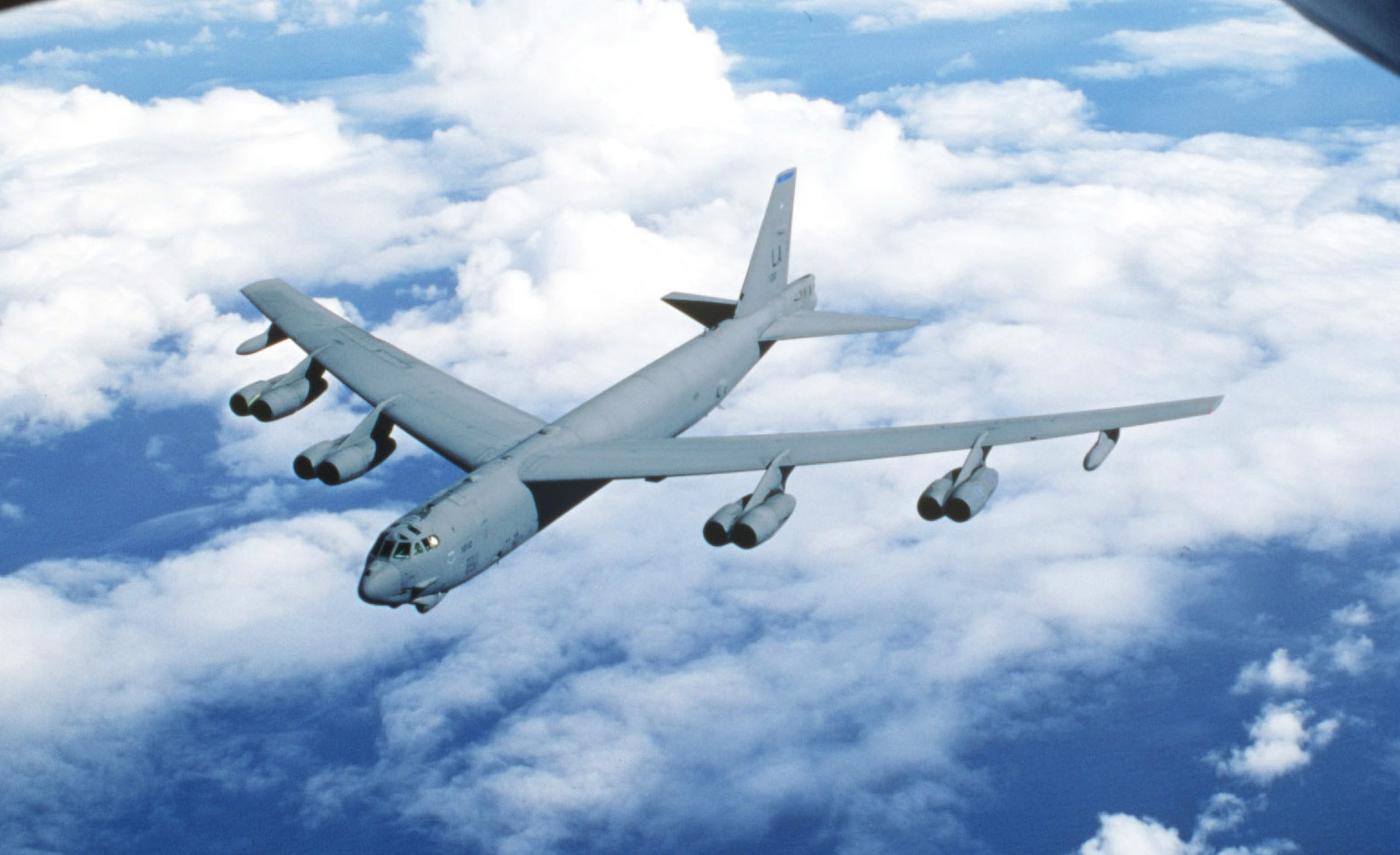
Air Combat Command's B-52 is a
long-range, heavy bomber that can perform a variety of missions. The
bomber is capable of flying at high subsonic speeds at altitudes up to
50,000 feet (15,166.6 meters). It can carry nuclear or precision guided
conventional ordnance with worldwide precision navigation capability.
|
B-52
Stratofortresses
Primary function: Heavy bomber
Speed: 650 mph
Crew: Five (aircraft commander, pilot, radar navigator, navigator
and electronic warfare officer)
Contractor:
Boeing Military Airplane Co.
Power
plant: Eight Pratt & Whitney engines TF33-P-3/103 turbofan
Thrust:
Each engine up to 17,000 pounds
Length:
159 feet, 4 inches (48.5 meters)
Height:
40 feet, 8 inches (12.4 meters)
Wingspan:
185 feet (56.4 meters)
Ceiling:
50,000 feet (15,151.5 meters)
Weight:
Approximately 185,000 pounds empty (83,250 kilograms)
Maximum
Takeoff Weight: 488,000 pounds (219,600 kilograms)
Range:
Unrefueled 8,800 miles (7,652 nautical miles)
Armament:
Approximately 70,000 pounds (31,500 kilograms) mixed ordnance -- bombs,
mines and missiles. (Modified to carry air-launched cruise missiles,
Harpoon anti-ship and Have Nap missiles.)
Accommodations: Six ejection seats
Unit
Cost: $53.4 million (fiscal 98 constant dollars)
Date
Deployed: February 1955
Inventory:
Active force, 85; ANG, 0; Reserve, 9
|
http://www.af.mil/news/factsheets/B_52_Stratofortress.html
http://www.af.mil/photos/Dec1998/04012b52.html
http://www.aerotechnews.com/phtoarc/webphot/B52/B52.html
http://www.zianet.com/jpage/airforce/weapons/air/b-52.html
http://www.globalsecurity.org/wmd/systems/b-52.htm

The most successful medium bomber of World War II was
the twin-engine, twin-tailed B-25 named for America’s best-known
pre-war champion of air bombardment, General “Billy” Mitchell.
Perhaps the most famous mission flown by
these bombers was the raid on Tokyo on April 18, 1942. In this fabled
attack, flown only months after the Japanese surprise attack on Perl
Harbor, Jimmy Doolittle led a force of 16 B-25s against the Japanese
capital. Launched in squall conditions from the cramped deck of the
aircraft carrier Hornet, these aircraft showed that no part of Japan
would be immune to the destructive power of the aerial forces of the
United States.
Armament (all): Two
0.50-inch machine guns in individual blisters on the left and right-hand
side of the fuselage with 400 rpg. Two 0.50-inch machine guns in top
turret, 400 rpg. Two 0.50-inch machine guns in waist position, 200 rpg.
Two 0.50-inch machine guns in tail turret, 600 rpg. Normal bomb load was
3000 pounds, but a maximum bombload of 4000 pounds could be carried on
short-range missions. Some had underwing racks for eight 5-inch high
velocity aircraft rockets (HVARs).
Armament
(medium bomber version): One flexible 0.50-inch
machine gun in nose, 300 rounds. One fixed 0.50-inch machine gun in
nose, 300 rounds. Beginning with B-25J-20, a second fixed 0.50-inch gun
was added in the nose.
Armament
(Strafer version): Eight 0.50-inch machine guns in
the nose with 400 rpg.
|
B-25
Mitchell Bomber
Primary
function: medium bomber
Speed: 230 mph cruise, 275 max
Crew: 6, pilot, co-pilot, navigator/bombardier/gunner,
turret gunner/engineer, radio
operator/waist gunner, and
tail gunner.
Power
plant: Two Wright R-2600-13 Double Cyclone
fourteen-cylinder air-cooled radials, rated at 1700 hp each
Thrust:
Length:
52 feet 11 inches
Height:
16 feet 4.2 inches
Wingspan:
67 feet 6.7 inches
Wing
area: 610 square feet
Ceiling:
24,000 ft
Weight
empty: 21,100
lbs
Weight
loaded: 33,000 lbs
Weight
Max: 35,000 lbs
Weight
Payload: 3000 - 5000 lbs
Maximum
Takeoff Weight:
Fuel
internal: 670 US gallons, external 304
Range:
1275 with 3200 lbs ordinance, 2700 miles empty
Climb
Rate: 1110 ft/min
Accommodations:
Contractor:
North American, 1939
Unit
Cost:
Date
Deployed: 1940
Inventory:
9,889 in 60 months, 700 to Navy and Marines
|
http://www.b25.net
http://www.b-25yellowrose.com
http://www.b25.net/b25jarmy.html
http://www.ixpres.com/ag1caf/usplanes/aircraft/mitchell.htm
http://www.boeing.com/companyoffices/history/bna/b25.htm
|
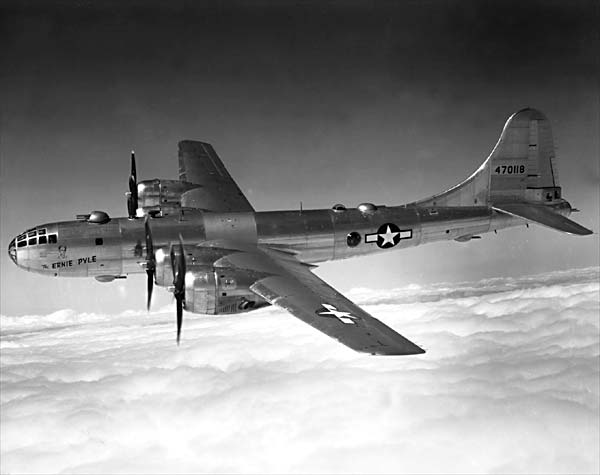
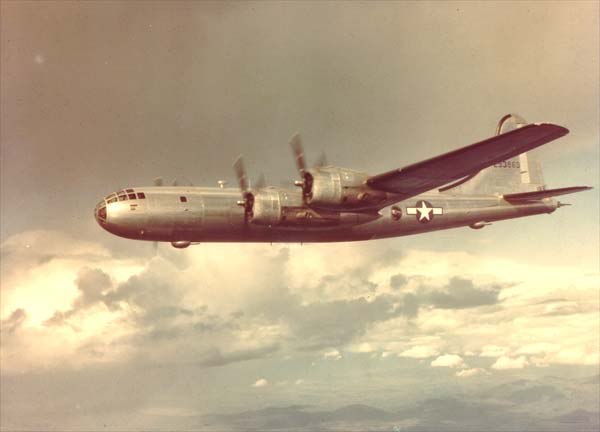
|
B-29
Superfortress
Primary
function: long-range strategic heavy bomber
Speed: 220 cruising, 365
mph
max
Crew: 10, Pilot, Co-Pilot, Engineer, Bombardier, Radioman, 5
Gunners
Power
plant: Four
R-3350-20/23
Wright Double Cyclone 18
Cylinder engines,
2,200
horsepower
Thrust:
Length:
99 feet
Height:
27' 9"
Wingspan:
141 feet 3 inches
Wing
Area: 1739.00 Sq Ft
Ceiling:
31,850 feet
(33,600 ft)
Weight
empty: 69,610.0 lbs
Weight
Gross: 105,000 pounds (140,000 pounds
postwar)
Weight
Payload: 20,000 lbs
Maximum
Takeoff Weight: 124,000 lbs
Range:
3700 miles
Armament:
12 .50-caliber
machine guns
(8 forward, 2
tail),
1 20 mm cannon
Accommodations:
Contractor:
Boeing, 1939
Unit
Cost: $639,000
Date
Deployed: 9/21/1942
Inventory:
Boeing 2,766, Bell Aircraft 668, Glenn Martin 536
|
Designed in
1940 as replacements for the B-17 and B-24, the B-29s were primarily
used in the Pacific theater during World War II. As many as 1,000
Superfortresses at a time bombed Tokyo, destroying large parts of the
city. Finally, on Aug. 6, 1945, the B-29 Enola
Gay dropped the world's first atomic bomb on Hiroshima. Three
days later a second B-29, Bockscar, dropped another atomic bomb on
Nagasaki. Shortly thereafter, Japan surrendered.
The B-29 had
many new features, including guns that could be fired by remote control.
The crew areas were pressurized and connected by a long tube over the
bomb bays. The tail gunner had a separate pressurized area that could
only be left during unpressurized flight. The B-29 was also the heaviest
production plane because of increases in range, bomb load and defensive
requirements.
After the war,
B-29s were adapted for several functions, including in-flight refueling,
anti-submarine patrol, weather reconnaissance, and rescue duty. The B-29
saw military service again in Korea between 1950 and 1953, battling new
adversaries: jet fighters and electronic weapons. The last B-29 in
squadron use retired from service in September 1960.
http://b-29.boeing.com/news/feature/b29/gallery
(photos)
http://www.boeing.com/companyoffices/history/boeing/b29.html
http://www.navismagazine.com/demo/b29/develop.htm
http://photo.starnet.ru/Thematic_Wallpapers/Aviacija_i_kosmonavtika/Bombardirovshchiki_i_razvedchiki/B-29_B-50_Tu-4/index.htm
http://www.xmission.com/~tmathews/b29/i.html
http://www.angelfire.com/in/rwachs
http://web.bryant.edu/~history/h364proj/summ_99/trainor/superfort.htm
http://www.ixpres.com/ag1caf/usplanes/aircraft/suprfort.htm
http://www.csd.uwo.ca/~pettypi/elevon/baugher_us/b029i.html
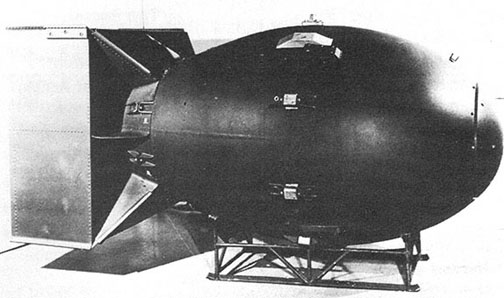
Fat Man
Model 1561. This 10,000 lb. Plutonium-based bomb
became the first standard nuclear weapon in the US arsenal
The 509th Composite Group was created under maximum secrecy
with the specific purpose of dropping atomic bombs on Japan. The codename of the
atomic bombing project was Silverplate.
Fifteen B-29's were allocated to Col. Paul Tibbet's group, all
Martin-Omaha modified bombers with an adapted bomb bay, Curtiss reversible pitch
propellers, a British-built release mechanism (the same used to drop the
gigantic 12,000 lb. "Tallboy") and no defensive armament except
for the tail guns. Only fourteen reached Tinian, the fifteenth was left behind
for unknown reasons. The group had its distinctive marking, a black arrow
pointing forward enclosed in a circle, but soon in order to confuse enemy spies,
spurious markings were painted on 509th CG tails. Col Tibbet's "Enola
Gay" was given the encircled "R" of the 6th BG and Maj.
Sweeney's "Bocks Car" that dropped the bomb on Nagasaki
received false 444th BG markings.
At the end of 1945,
509th CG was transferred to Roswell Army Air Force Field, NM and
their atomic bomb-capable B-29's grew to 30 in about a year. In 1948 the Cold
War had already started and the Joint Chief of Staff decided that USAF
should have at least 250 atomic bombers to achieve a credible nuclear deterrent:
255 B-29's, B-50's and B-36's were modified for the purpose. The program,
codenamed Gem, included this four sub-programs:
return to top









